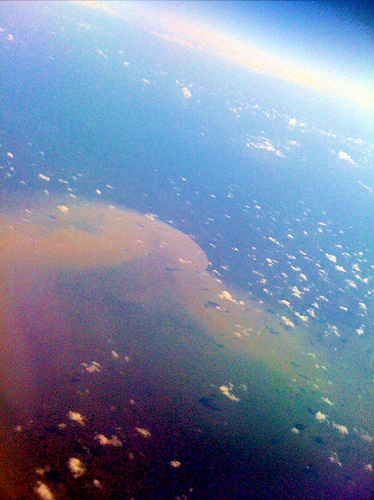It wasn’t so long ago the notion of 25,000 barrels of oil spewing from the Gulf well each day was a worst-case estimate, compared to the 12,000 to 19,000 figure that the government had deemed reasonable. On Thursday, the government announced that it believes the spill is likely between 20,000 and 40,000. One group’s figures, though, put it as high as 50,000 barrels per day. That highest estimate means that as many as 2.1 million gallons of oil could be gushing into the Gulf every day.
Thursday is the 52nd day since the disaster started. If you take the upper estimate, that would mean 109.2 million gallons of oil have spilled into the Gulf—already roughly 10 times more than the Exxon Valdez spill. Even if you used the lower bound, 54 million gallons have poured out—almost five times more than Exxon Valdez.
And it gets worse. These figures are from before the riser leading from the well was cut to put in place the cap that is now funneling a portion of the oil to the surface. Cutting the riser may have increased the flow by 20 percent. The company reports that it’s siphoning 15,000 barrels per day using the cap, but much of the total flow it’s catching.
In a call with reporters, Marcia McNutt, director of the US Geological Survey and head of the flow rate team, chose her words carefully, stating that they believe the “credible” estimate now is somewhere between 20,000 and 40,000 barrels. But McNutt added a qualifier, saying that the higher-end estimate was “somewhere around there, maybe a little bit more.” The last time the government rolled out a new estimate, it was criticized for underestimating the size.
The latest report pulls together estimates from three separate teams. An additional team, headed by Energy Secretary Steven Chu, has yet to release figures. The highest estimate is drawn from the work of team of experts lead by Woods Hole Oceanographic Institution and researchers from Johns Hopkins University, the University of Georgia and MIT, which used acoustic technologies to measure flow rates.
Peppered with questions from reporters about why the range remains so large, McNutt acknowledged that before this disaster, not a lot of attention had been paid to this area of research. Evaluating this spill will help improve their methods, she said. “We will be able to do a much better job next time.”
I’m kind of hoping we don’t have a “next time.” But maybe that’s just me.











